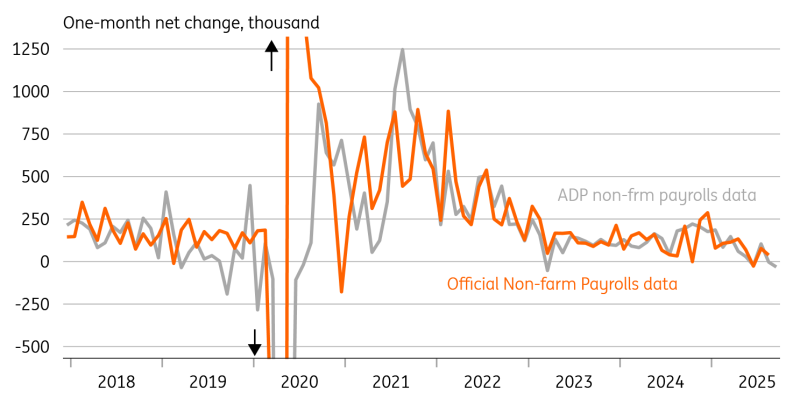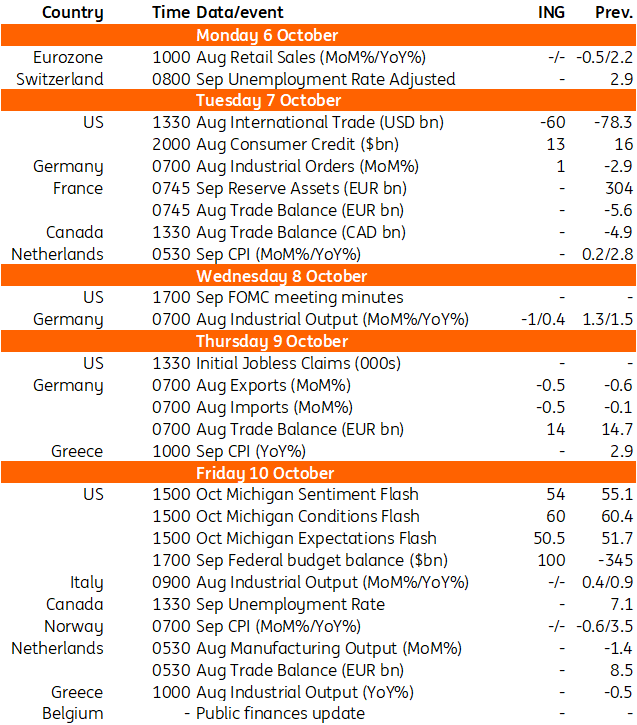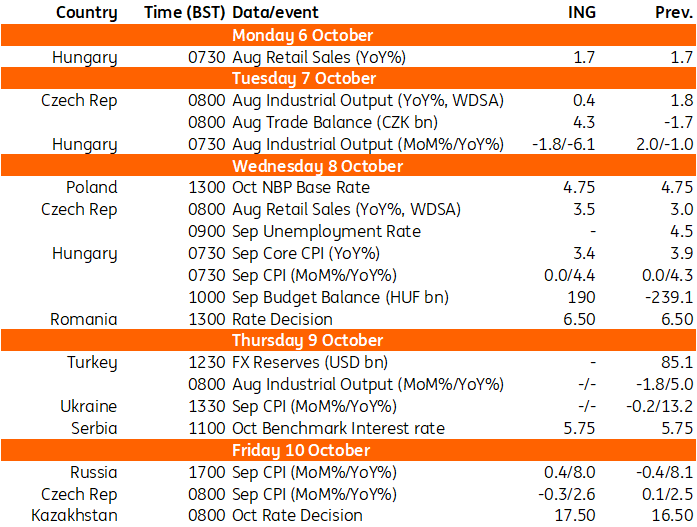TSX jumps amid Fed rate cut hopes, ongoing U.S. government shutdown
America’s government has shut down, and I’m having a crisis. A bit like when Tom Cruise screams ’Show me the money!’ in Jerry Maguire, I’m craving the data. We don’t even have the US jobs numbers. If that weren’t enough, I’m getting worried about more surprises in the coming months from tariffs. Deep breath…
How to Survive Data Deprivation
So, how to look ahead to next week, seeing as these really are tricky times for us economists. Some have resorted to reading the tea leaves instead, or, as Wall Street calls it, the ADP employment estimate. It’s the closest thing we have to the hallowed and now-delayed jobs report, and it was quite bad this week. It showed private-sector jobs down 32,000 in September, even if its correlation with the official data is often questionable.
Others – heaven forbid – have been forced to talk to actual, real-life people. The Fed’s Beige Book, a collection of anecdotes on the US economy, is out in a couple of weeks. The last one was already talking about weaker hiring demand and, in some cases, layoffs. In the absence of key data, this is going to take on outsized significance ahead of the October Fed decision.
Yet in reality, a cut is fully priced for this month, and the same is virtually true of December’s meeting. The much bigger debate is what happens in 2026. And the government shutdown – and the resulting data void – is unlikely to materially change that. So long as the shutdown doesn’t last for ages, the workers affected will return to their jobs with backdated pay with minimal lasting economic damage. The jury’s out on whether threats of mass firings will come to fruition.
Indeed, in many ways, the more intriguing story in Washington this week was the deal between the White House and Pfizer, which saw the latter reduce drug prices in America in exchange for a three-year tariff reprieve.
This confirms what has been rumoured for some time, namely that tariff negotiations are increasingly bypassing national governments and taking place directly with major manufacturers. European carmakers have previously said they are looking for similar tariff rebates in exchange for big investment pledges in the US.
This raises three interesting questions.
Firstly, if done at scale, do these deals pose an upside risk to European growth, where August’s EU-US deal seems to have largely failed (check out Ruben Dewitte’s report on the damage so far)? The answer, I suspect, depends on whether the companies involved see these deals standing the test of time – more on that in a minute.
Secondly, what does it mean for the future of pharmaceutical tariffs? Remember, these would be a big deal because blanket 25% levies across all pharma products would lift America’s average tariff rate from 18% today to 20%, if my maths is right. But for a while now, my personal view has been that these tariffs won’t see the light of day – or at least not without a hefty delay or considerable exemptions. Deals with major companies might be one way of achieving that.
Thirdly, are elevated country-specific tariffs being used as a negotiation tool to bring these companies to the table? I’m thinking mainly of Switzerland here, which still faces a 39% tariff. Deals with its major pharmaceutical industry would bring much-needed relief, but will they also encourage the US government to lower the overall tariff rate to the 15% that the EU is currently charged?
That’s the optimistic take, anyway. As for the pessimistic one, well, remember the President’s use of emergency powers to impose tariffs on foreign trading partners will soon come under scrutiny by the Supreme Court. It will hear arguments on 5 November, and a decision could come before the end of the year. Many legal experts seem to think the President could lose.
Maybe that sounds positive, inasmuch as tariffs would come down – and remember this ruling covers the majority of tariffs imposed this year, including everything on specific countries. But in practice, there would probably be chaos, given that importers would likely be eligible for refunds on tariffs paid so far. And anyway, there are other legal means the President can use to quickly rebuild a tariff wall. The result would almost certainly be more uncertainty.
Even if those tariffs are upheld, we come back to that question of how long the trade deals agreed over the summer actually last. Here, it’s worth keeping an eye on developments between Japan & South Korea and the US on their respective investment pledges. There seems to be some debate over how much of those pledges - $550 billion from Japan, $350 billion from South Korea – will come in the form of loan guarantees or cash/equity investments. Could disagreements here see US tariffs go back up again for these countries?
Plenty to keep us economists busy, then, in the long and agonising wait for more economic data. And remember, if you get really desperate, you can always just make up your own numbers.
In totally unrelated news, we’ll be publishing our latest forecasts next week. Keep your eyes peeled!
Chart of the Week: ADP Data Suggests Job Numbers Fell in September

Source: Macrobond, ING
Think Ahead in Developed Markets
United States
Government Shutdown: Depending on how long the government shutdown lasts, we may not be getting many government-produced economic statistics over the coming week, if at all. Even if a deal is struck in the next few days, it will take time for people to return to work and get the data release schedule back on track. Next week’s releases that are vulnerable to delay are the trade balance, jobless claims numbers and inventory numbers.
FOMC Minutes (Wed): Nonetheless, the Federal Reserve will be releasing the September FOMC meeting minutes, where they cut rates 25bp, and the August consumer credit data. We will also get the preliminary October University of Michigan consumer sentiment index. While spending is holding up for now, we’ve seen hefty drops in consumer confidence this year on job market weakness and concerns about squeezed spending power from tariff-induced price hikes. With three million Federal government workers not receiving paychecks and many furloughed workers being threatened with permanent layoff, it is hard to imagine sentiment will improve by much.
Think Ahead in Central and Eastern Europe
Poland
NBP rate decision (Wed): The October National Bank of Poland decision will be a close call and local analysts are evenly split between those who expect a 25bp and those expecting a pause. We are in the second camp as policymakers stress various risks, including loose fiscal policy, as a main rationale for a cautious approach to further policy easing. The Monetary Policy Council (MPC) has already reduced policy rates by 100bp this year, but still refrains from calling its moves a cycle. A pause in October would be more consistent with “monetary adjustment” strategy. At the same time, the fact that the electricity price freeze was formally extended for 4Q25 and September flash CPI inflation surprised to the downside may make some policymakers lean more towards a cut already this month. We still expect only one more 25bp cut this year and November, when the new NBP projection is published, seems more likely than October.
Hungary
Retail/Industry (Mon/Tue): We expect a mixed bag of economic activity data in Hungary next week, with retail sales potentially providing positive news, while industrial production is expected to suffer due to an extended summer shutdown. Due to a difference in the number of working days, the raw industry data could be especially disheartening.
Inflation (Wed): The headline inflation continued to be contained by the government’s price shield measures, with prices remaining stable on a monthly basis. Seasonality (mainly in services and clothing) will drive core inflation down, but we also expect the stronger Hungarian forint to have a downward impact on imported goods prices.
Romania
NBR rate decision (Wed): We expect the National Bank of Romania (NBR) to keep rates on hold at the 8 October meeting, despite the sustained pick up in inflationary pressures more recently. Demand-side factors are also at play, and risks for growth are to the downside. We think that policymakers will look through this inflationary spike, and our base case remains for the next rate cut in May 2026.
Czech Republic
Inflation (Fri): Annual inflation likely increased marginally in September, reflecting a less pronounced negative contribution from fuel prices. Core and food inflation are likely to have remained elevated. The industrial output dynamic is expected to have remained in positive territory in August, as Czech industry gradually stabilises. Robust real wage dynamics and positive sentiment likely translated to continued solid consumer spending in the same month.
Kazakhstan
NBK rate decision (Fri): We expect the central bank of Kazakhstan (NBK) to raise the base rate (10 October), currently at 16.50%, by 50-100 basis points following the demand and domestic tariff-driven acceleration of CPI growth to the more-than-expected 12.9% YoY as of September, and continued weakness in the tenge in September. This hike should complement the earlier decisions to tighten the macroprudential requirements and to boost net government FX sales from $1.0 bn in September to $1.5bn in October.
Key Events in Developed Markets Next Week

Source: Refinitiv, ING
Key Events in EMEA Next Week

Source: Refinitiv, ING
Disclaimer: This publication has been prepared by ING solely for information purposes irrespective of a particular user’s means, financial situation or investment objectives. The information does not constitute investment recommendation, and nor is it investment, legal or tax advice or an offer or solicitation to purchase or sell any financial instrument. Read more
